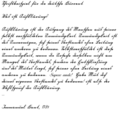Kurrent


Kurrent is an old form of German-language handwriting based on late medieval cursive writing, also known as Kurrentschrift, Alte Deutsche Schrift ("old German script") and German cursive. Over the history of its use into the first part of the 20th century, many individual letters acquired variant forms.
German writers used both cursive styles, Kurrent and English cursive, in parallel: location, contents and context of the text determined which script style to use.
Sütterlin is a modern script based on Kurrent that is characterized by simplified letters and vertical strokes. It was developed in 1911 and taught in German schools as primary script from 1935 until the beginning of January, 1941. Then it was replaced with "normal German handwriting", which is sometimes referred to (correctly but confusingly) as "Latin writing". See Ausgangsschrift for examples of post-1941 school handwriting samples.
Lettering examples

 Manuscript by Wilhelm Busch (undated, late 19th century)
Manuscript by Wilhelm Busch (undated, late 19th century)- Example from a book published in 1905
 Kurrent script used for text in a 1916 children's book
Kurrent script used for text in a 1916 children's book Signage on a municipal children's home in Esslingen am Neckar in 2006
Signage on a municipal children's home in Esslingen am Neckar in 2006 Computer font version (text from What is Enlightenment? by Immanuel Kant)
Computer font version (text from What is Enlightenment? by Immanuel Kant) Kurrent script from a 1903–14 primer on German, the 26 letters, ligatures, start of sample text
Kurrent script from a 1903–14 primer on German, the 26 letters, ligatures, start of sample text Kurrent script from a 1903–14 primer on German, the rest of the sample text
Kurrent script from a 1903–14 primer on German, the rest of the sample text Final paragraph of a German contract from 1750 signed by George II of Great Britain. It contains a mixture of Kurrent and 'Latin font' scripts.
Final paragraph of a German contract from 1750 signed by George II of Great Britain. It contains a mixture of Kurrent and 'Latin font' scripts.
See also
- Antiqua-Fraktur dispute
- Blackletter
- Eszett (letter ß)
- Fraktur (script)
- Sütterlin handwriting
- Grundschrift handwriting
External links
| Wikimedia Commons has media related to German Kurrent. |
- German handwriting Schrift (German) Overview and examples of Kurrent.
- The typeface used to set the example text above
- German language page about Kurrent, with history of German cursive handwriting and Kurrent
- Another version, by Lars Erik Bryld, called Manu Gothica
- Yet another version, by Peter Wiegel
- More information about German Kurrent

